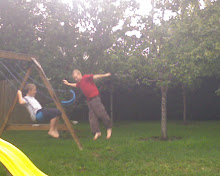I saw this on a site, and thought it was a good list. So, I thought I'd post it here, just in case anyone is curious. I especially like #1, #2, and #6. :-) Have a great week!
When You Meet a Person Who Uses A Wheelchair
from: http://www.dizabled.com/wheelchair-etiquette/
1. Do not automatically hold on to a person’s wheelchair. It is part of the person’s body space. Hanging or leaning on the chair is similar to hanging or leaning on a person sitting in any chair. It is often fine if you are friends, but inappropriate if you are strangers.
2. Offer assistance if you wish, but do not insist. If a person needs help (s)he will accept your offer and tell you exactly what will be helpful. If you force assistance it can sometimes be unsafe as when you grab the chair and the person using it loses his/her balance.
3. Talk directly to the person using the wheelchair, not to a third party. The person is not helpless or unable to talk.
4. Don’t be sensitive about using words like “walking” or “running.” People using wheelchairs use the same words.
5. Be alert to the existence of architectural barriers in your office and when selecting a restaurant, home, theatre or other facility, to which you want to visit with a person who uses a wheelchair.
6. If conversation proceeds more than a few minutes and it is possible to do so, consider sitting down in order to share eye level. It is uncomfortable for a seated person to look straight up for a long period.
7. When children ask about wheelchairs and people who use them, answer them in a matter-of-fact manner. Wheelchairs, bicycles and skates share a lot in common.
8. Make sure meeting places are architecturally accessible (with ramps, modified bathrooms, wide doors, low telephones, etc.) so that people with disabilities can be equal participants.
9. Encourage your community to put “curb cuts” in sidewalks. These inexpensive built-in ramps enable wheelchair users to get from place to place independently.
10. Make it a point to try to reduce barriers in your physical surroundings. Often these barriers have been created by architects, engineers and builders who were unaware. A simple “How could someone using a wheelchair get in here?” will help identify any barriers.
Taken from the handbook entitled Free Wheeling published by the Regional Rehabilitation Research Institute on Attitudinal, Legal and Leisure Barriers, Washington, D.C.




1 comment:
This is an informative and very helpful list. Number one would have never dawned on me, but it makes so much sense reading it! I worked in an office where one of the employees used a seeing eye dog and they sent out a similar list of ground rules. It helped me so much. This is good to know.
Post a Comment